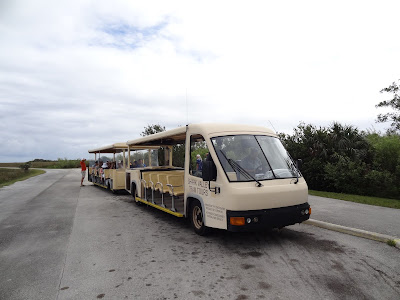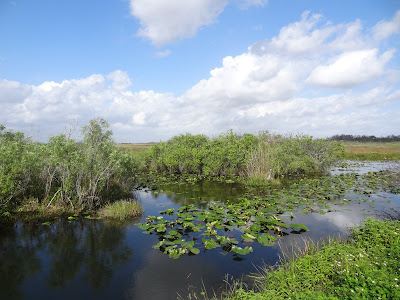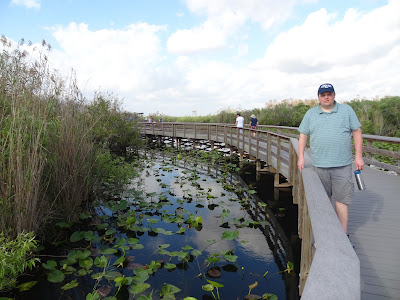Visited: Feb 2019
Nearby city: Miami, FL; Homestead, FL
"If the devil ever raised a garden, the Everglades was it."
-James Carlos Blake in Red Grass River: A Legend
This unique national park protects a large swath of land on the southwestern portion of the Florida peninsula. Although the Everglades is characterized as a swamp (under the basic definition that a swamp is forested wetland), it is much more. It's a stunningly diverse and dynamic ecosystem; from freshwater sloughs to hardwood hammocks, pinelands, cypress domes and mangroves; a tropical wilderness teeming with life; a "river of grass."
This wet prairie, which is flooded for most of the year, is not stagnant water. The water is flowing ever so slowly, so slowly that it's imperceptible. This horizon-wide river is interrupted every so often by small patches of higher ground (called hammocks) that offer the only parts of the park that are dry throughout the year. The Everglades is home to a number of species; the Florida Panther, the manatee, and a huge variety of birds, the Everglades is the most significant breeding ground for tropical wading birds in all of North America. Here you will find anhinga (birds with a snakelike neck), great herons, wood storks, ibis, and if you're lucky a colorful roseate spoonbill or a flamingo. The Everglades is the only place in the world where you can find crocodiles and alligators living side by side. Crocodiles are rare, but they are found in the park, living in the brackish water (mixture of salt-and-fresh water) along with their fresh-water cousins.
A mere 150 years ago, the Everglades covered a much larger area of southern Florida, essentially the entire peninsula south of Lake Okeechobee. After the US forced the Seminole Indians (who inhabited most of northern Florida) to relocate to modern-day Oklahoma after the Seminole Wars in 1842, a few Seminole tribes escaped to the swamps and marshlands to the south to avoid the relocation. Until the 1920s or so, they and the similar Miccosukee tribe lived in near-total isolation. Around the turn of the 20th century, efforts were made to drain the wetlands and develop the land for agricultural and residential use. As cities like Miami and Fort Lauderdale exploded with population, the Everglades began to shrink.
Thanks to the efforts of reporter Marjory Stoneman Douglas and landscape architect Ernest F. Coe, the Everglades was saved from total extinction. Everglades National Park was dedicated in 1947, and restoration efforts have been made since to expand and designate more park land as wilderness area in the 1970s and 1980s.
Visiting Everglades National Park is a wonderful and unique experience. First of all, the Park is huge. There are four visitors centers: (1) Shark Valley Visitor Center - along the Tamiami Trail and the closest part of the Park to Miami; (2) Gulf Coast Visitor Center - on the western edge of the park, along the Gulf of Mexico; (3) Ernest F. Coe Visitor Center - near the town of Homestead; and (4) Flamingo Visitor Center - deep in the interior of the park on Florida Bay and a popular spot for kayaking in the Everglades and mangroves. You're probably going to want to devote a couple of days to explore all these areas of the Park. We visited all but the Gulf Coast Visitor Center.
Another thing to consider is time of year for visit. There are two seasons in Everglades: wet and dry. The wet season is May - November. It is hot, humid, buggy, lots of mosquitoes and since the water sources spread out, the wildlife does too; and of course, lots of rain. The dry season is December - April. This is the time you want to visit, not as hot nor humid, not as buggy and you'll see much more wildlife.
We started our visit at the Shark Valley Visitor Center. Here you will find Shark Valley Loop Road. This 15-mile loop road is perfect for wildlife viewing. You can walk it, or rent a bike. But the prime way to see it is on the tram tour. I highly recommend the tram tour. It's relatively cheap, not too long, and you'll get lots of info about the park from your guide; our guide was excellent.
Our guide told us that the novelty of seeing alligators along the tour would get old after a while...and he was right. We saw SO MANY alligators. By the end of the tour, we stopped taking pictures of them. But, it was amazing to see these giants...and kind of scary too. Just keep your distance...and don't go swimming.
The american alligator can grow up to 15 feet long and weigh up to 1,000 pounds. Their ubiquitous presence in the Everglades is an environmental success story. Nearly hunted to extinction, the alligator was placed on the Endangered Species list in 1967, but were removed in 1987 and is now considered to be fully recovered. At this point, just know that if there is a natural body of freshwater in the state of Florida, there are going to be alligators in it. Thankfully, alligators are nowhere near as aggressive as crocodiles, just maintain a ton of respect and a healthy distance. If you leave an alligator alone; they'll leave you alone.
Another highlight of the Shark Valley tram tours were the birds. Our group had a lot of bird-watchers on it. They were an enthusiastic bunch. 😊 They loved seeing all the herons, and we even got the rare treat of seeing a roseate spoonbill, with it's brilliant pink plumage. It was pretty far in the distance though.
 |
| roseate spoonbill |
 |
| Anhinga (aka snakebird) |
 |
| Great Heron |
 |
| in the back you can see a hammock, that constitutes the "high ground" in the Everglades |
Halfway through the tour you'll stop for a few minutes at the Observation Tower. Get out and stretch your legs and go get an awe-inspiring view of the surrounding countryside.
Near the Shark Valley Visitor Center (along the main highway - the Tamiami Trail), you'll find a number of spots where you can take an airboat tour through the wetlands. I also highly recommend doing this, it's lots of fun. There are three operators who are licensed to give tours within the park boundaries. We decided to go with Gator Park. The cheaper/shorter option is to take a tour on a large airboat (fits like 20 people or so) and pair it up with a croc and gator show. Or you can plunk down the money (couple hundred of dollars) and take a longer tour on an airboat that only seats around 4-5 people. If we went again, I'd probably just spend the money and do tour on the smaller airboat. Either way, it was a lot of fun.
The next day we took Florida Highway 9336 to go more into the interior of the Park and visit the Ernest F. Coe Visitor Center and the Flamingo Visitor Center. Make sure to stop and do the Anhinga Trail (an elevated boardwalk that provides lots of wildlife viewing opportunities) and the Gumbo Limbo Trail. Both are short enjoyable trails. Also stop at the Pa-hay-okee Overlook and the Mahogany Overlook.
 |
| Gumbo Limbo Trail |
 |
| Anhinga Trail |
 |
| Don't get too close! 😲 |
 |
| turtle |
 |
| Mahogany Hammock |
 |
| Flamingo Visitor Center |
The Everglades were a very impressive and entertaining visit. Tara and I loved seeing all the wildlife and experiencing this unique environment. For more info: https://www.nps.gov/ever/index.htm


























































